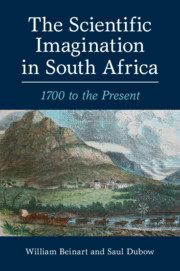Book contents
- The Scientific Imagination in South Africa
- The Scientific Imagination in South Africa
- Copyright page
- Contents
- Map
- Figures
- Acknowledgements
- Introduction: The Scientific Imagination in South Africa
- 1 Scientific Imagination and Local Knowledge at the Cape in the Eighteenth Century
- 2 Scientific Governance and Colonial Institutions, c. 1800–70
- 3 Technological Innovation and the Scientific Imagination in Mining and Agriculture, 1870–1902
- 4 Science, Reconstruction and the Imagining of the First ‘New’ South Africa, 1902–29
- 5 The Commonwealth of Knowledge, 1930–48
- 6 The Republic of Science, 1948–90
- 7 Big Science and Indigenous Knowledge: Post-Apartheid South Africa and the African Renaissance
- Afterword
- Select Bibliography
- Index
Introduction: The Scientific Imagination in South Africa
Published online by Cambridge University Press: 07 May 2021
- The Scientific Imagination in South Africa
- The Scientific Imagination in South Africa
- Copyright page
- Contents
- Map
- Figures
- Acknowledgements
- Introduction: The Scientific Imagination in South Africa
- 1 Scientific Imagination and Local Knowledge at the Cape in the Eighteenth Century
- 2 Scientific Governance and Colonial Institutions, c. 1800–70
- 3 Technological Innovation and the Scientific Imagination in Mining and Agriculture, 1870–1902
- 4 Science, Reconstruction and the Imagining of the First ‘New’ South Africa, 1902–29
- 5 The Commonwealth of Knowledge, 1930–48
- 6 The Republic of Science, 1948–90
- 7 Big Science and Indigenous Knowledge: Post-Apartheid South Africa and the African Renaissance
- Afterword
- Select Bibliography
- Index
Summary
South Africa was a regional rather than a world power; it was not a global centre for invention or new scientific ideas. Yet its geographic position on the African continent made it a staging post for Portuguese, Dutch and British colonialism and part of a global imaginary. Colonisation by Britain brought the region into connection with a technologically advanced world empire. South Africa was at key moments an incubator and testing ground of innovation, which had profound social and economic effects on the country: agricultural technology underpinned exports of wool and ostrich feathers; new rifles changed the balance of power in favour of colonial regimes; the mineral revolution necessitated developments in applied geology and gold extraction. Key advances were often a response to urgent economic requirements, but the scientific imagination was also more exploratory with respect to astronomy, palaeontology, and wildlife conservation. And as a crucible of racial politics in the twentieth century, South Africa has long been seen as a social laboratory for the study of 'race relations'. We aim to illustrate the scientific imagination as an expression of human curiosity and ingenuity, to discuss the politics of science and to examine its imbrication with white political power.
Keywords
- Type
- Chapter
- Information
- The Scientific Imagination in South Africa1700 to the Present, pp. 1 - 28Publisher: Cambridge University PressPrint publication year: 2021



